登録情報 データベース : EMDB / ID : EMD-23051タイトル Focused map of the Hsp90-Hsp70-Hop-GR client-loading complex: Hsp90-CTDs:Hop-DP2:GR-Helix1 Raw (unsharpened) map from Relion's refine3d. 複合体 : Hsp90-Hsp70-Hop-GR complex機能・相同性 分子機能 ドメイン・相同性 構成要素
/ / / / / / / / / / / / / / / / / / / / / / / / / / / / / / / / / / / / / / / / / / / / / / / / / / / / / / / / / / / / / / / / / / / / / / / / / / / / / / / / / / / / / / / / / / / / / / / / / / / / / / / / / / / / / / / / / / / / / / / / / / / / / / / / / / / / / / / / / / / / / / / / / / / / / / / / / / / / / 生物種 Homo sapiens (ヒト)手法 / / 解像度 : 3.46 Å Wang RY / Agard DA 資金援助 Organization Grant number 国 Howard Hughes Medical Institute (HHMI)
ジャーナル : Nature / 年 : 2022タイトル : Structure of Hsp90-Hsp70-Hop-GR reveals the Hsp90 client-loading mechanism.著者 : Ray Yu-Ruei Wang / Chari M Noddings / Elaine Kirschke / Alexander G Myasnikov / Jill L Johnson / David A Agard / 要旨 : Maintaining a healthy proteome is fundamental for the survival of all organisms. Integral to this are Hsp90 and Hsp70, molecular chaperones that together facilitate the folding, remodelling and ... Maintaining a healthy proteome is fundamental for the survival of all organisms. Integral to this are Hsp90 and Hsp70, molecular chaperones that together facilitate the folding, remodelling and maturation of the many 'client proteins' of Hsp90. The glucocorticoid receptor (GR) is a model client protein that is strictly dependent on Hsp90 and Hsp70 for activity. Chaperoning GR involves a cycle of inactivation by Hsp70; formation of an inactive GR-Hsp90-Hsp70-Hop 'loading' complex; conversion to an active GR-Hsp90-p23 'maturation' complex; and subsequent GR release. However, to our knowledge, a molecular understanding of this intricate chaperone cycle is lacking for any client protein. Here we report the cryo-electron microscopy structure of the GR-loading complex, in which Hsp70 loads GR onto Hsp90, uncovering the molecular basis of direct coordination by Hsp90 and Hsp70. The structure reveals two Hsp70 proteins, one of which delivers GR and the other scaffolds the Hop cochaperone. Hop interacts with all components of the complex, including GR, and poises Hsp90 for subsequent ATP hydrolysis. GR is partially unfolded and recognized through an extended binding pocket composed of Hsp90, Hsp70 and Hop, revealing the mechanism of GR loading and inactivation. Together with the GR-maturation complex structure, we present a complete molecular mechanism of chaperone-dependent client remodelling, and establish general principles of client recognition, inhibition, transfer and activation. 履歴 登録 2020年11月30日 - ヘッダ(付随情報) 公開 2021年12月8日 - マップ公開 2021年12月8日 - 更新 2022年2月2日 - 現状 2022年2月2日 処理サイト : RCSB / 状態 : 公開
すべて表示 表示を減らす
 データを開く
データを開く 基本情報
基本情報 マップデータ
マップデータ 試料
試料 機能・相同性情報
機能・相同性情報 Homo sapiens (ヒト)
Homo sapiens (ヒト) データ登録者
データ登録者 米国, 1件
米国, 1件  引用
引用 ジャーナル: Nature / 年: 2022
ジャーナル: Nature / 年: 2022

 構造の表示
構造の表示 ムービービューア
ムービービューア SurfView
SurfView Molmil
Molmil Jmol/JSmol
Jmol/JSmol ダウンロードとリンク
ダウンロードとリンク emd_23051.map.gz
emd_23051.map.gz EMDBマップデータ形式
EMDBマップデータ形式 emd-23051-v30.xml
emd-23051-v30.xml emd-23051.xml
emd-23051.xml EMDBヘッダ
EMDBヘッダ emd_23051.png
emd_23051.png http://ftp.pdbj.org/pub/emdb/structures/EMD-23051
http://ftp.pdbj.org/pub/emdb/structures/EMD-23051 ftp://ftp.pdbj.org/pub/emdb/structures/EMD-23051
ftp://ftp.pdbj.org/pub/emdb/structures/EMD-23051 emd_23051_validation.pdf.gz
emd_23051_validation.pdf.gz EMDB検証レポート
EMDB検証レポート emd_23051_full_validation.pdf.gz
emd_23051_full_validation.pdf.gz emd_23051_validation.xml.gz
emd_23051_validation.xml.gz emd_23051_validation.cif.gz
emd_23051_validation.cif.gz https://ftp.pdbj.org/pub/emdb/validation_reports/EMD-23051
https://ftp.pdbj.org/pub/emdb/validation_reports/EMD-23051 ftp://ftp.pdbj.org/pub/emdb/validation_reports/EMD-23051
ftp://ftp.pdbj.org/pub/emdb/validation_reports/EMD-23051 リンク
リンク EMDB (EBI/PDBe) /
EMDB (EBI/PDBe) /  EMDataResource
EMDataResource マップ
マップ ダウンロード / ファイル: emd_23051.map.gz / 形式: CCP4 / 大きさ: 125 MB / タイプ: IMAGE STORED AS FLOATING POINT NUMBER (4 BYTES)
ダウンロード / ファイル: emd_23051.map.gz / 形式: CCP4 / 大きさ: 125 MB / タイプ: IMAGE STORED AS FLOATING POINT NUMBER (4 BYTES) 試料の構成要素
試料の構成要素 Homo sapiens (ヒト)
Homo sapiens (ヒト)
 解析
解析 試料調製
試料調製 電子顕微鏡法
電子顕微鏡法 FIELD EMISSION GUN
FIELD EMISSION GUN
 画像解析
画像解析 ムービー
ムービー コントローラー
コントローラー












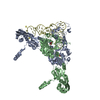
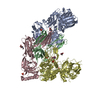
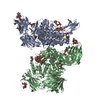







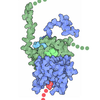














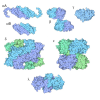





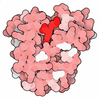




 Z (Sec.)
Z (Sec.) Y (Row.)
Y (Row.) X (Col.)
X (Col.)





















